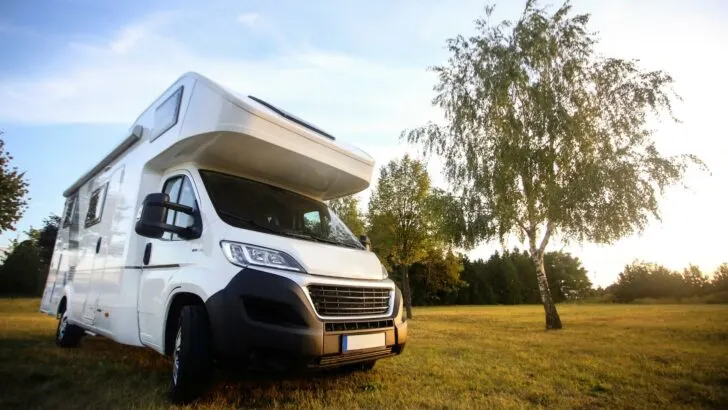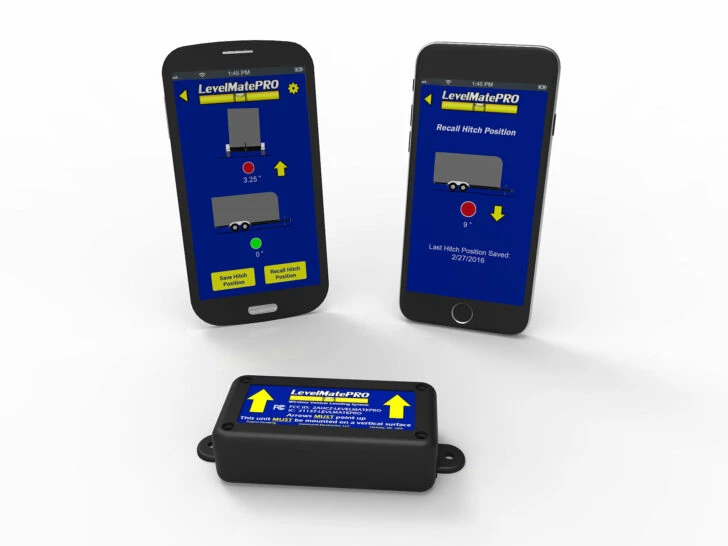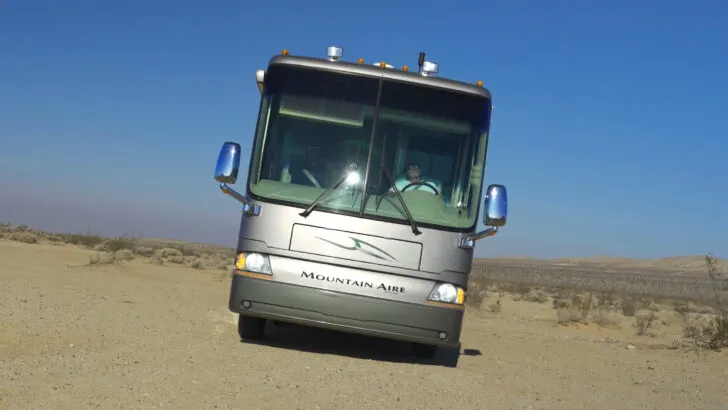It’s time to get that RV leveling system installed and running to keep you on the level throughout the camping season. RV leveling systems aren’t all the same, though, so today we’re sharing our favorite RV leveling system and we’ll tell you – and show you – why we love it!
You know we always level with you – so let’s get to it!
- 1) What Is an RV Leveling System?
- 2) Why Is It Important to Level an RV?
- 3) What Is the LevelMate Pro RV Leveling System?
- 4) How Do I Level an RV With Jacks Using the LevelMate Pro?
- 5) How Do I Level an RV Without Jacks Using the LevelMate Pro?
- 6) How Do I Level a Travel Trailer Using the LevelMate Pro?
- 7) How Much Does the LevelMate Pro RV Leveling System Cost and Where Can I Buy One?
What Is an RV Leveling System?
If you have a motorhome, a travel trailer, or a 5th wheel, or if you’ve ever camped in one, you know that leveling your RV is a must. There are lots of ways to level a rig, and in fact, many rigs come with built-in leveling mechanisms. In fact, our motorhome has hydraulic jacks, once a state-of-the-art leveling system. However, even hydraulic jack systems present leveling challenges – more on that later.
In short, an RV leveling system allows you to get your RV nice and level so that you’re comfortable in the RV and so that your appliances work properly.
Most places where we park aren’t completely level. Some adjustments need to be made in almost every location. Sometimes the necessary adjustments are minor, and sometimes they’re major!
Why Is It Important to Level an RV?

RVs need to be leveled for many reasons, including the comfort of the occupants and the proper functioning of appliances.
In addition to your comfort when walking or sleeping (no one wants to walk uphill or sideways in their RV or sleep at an angle), there are other important reasons to make your RV nice and level when you arrive at your destination.
Most RV refrigerators need to be kept close to level in order to operate properly because RV propane/electric fridges can’t work as intended if the coolant (ammonia) inside isn’t able to properly circulate. And this won’t happen if the rig isn’t level. You only have to lose all of the food in your freezer or fridge once to realize that it’s not okay to park on a slope. And in fact, it’s possible for your RV fridge to stop working completely if you’ve attempted to use it on a non-level surface too often.
Also, if your RV has slide-outs, you’re better off leveling the rig before you deploy them. As a matter of fact, most RV manufacturers instruct RV owners to level the rig FIRST and only put the slides out after doing so. This is because deploying them at an angle puts excessive stress on the slide mechanisms. And if you’re TOO far off level, it’s even possible to break the shear pins on your slide-out gears.
When water pools at one end of the shower stall, you know you’re not on the level. And if your drain is on the opposite side, well – now you’ve really got an issue.
Try cooking on a slanted stove (fried eggs anyone?), or walking into the bathroom door that’s swung open in the middle of the night. It’s not good.
So, for lots of reasons, it’s super important to level your RV when you’re setting up camp whether it’s for the day, a week, or longer.
What Is the LevelMate Pro RV Leveling System?
The LevelMatePRO RV leveling system uses Bluetooth technology and a 3-axis accelerometer to give you a convenient and easy-to-use system to assist with leveling your RV.

Whether you’ve got a motorhome or a travel trailer, the LevelMatePRO and LevelMatePRO+ are the best RV leveling systems you could own.
Using wireless technology, the LevelMatePRO reports the precise amount of height needed to level your RV and sends the information to the LevelMatePRO app on your smartphone or tablet. So, you stand still, look at your phone, and the LevelMatePRO gives you all the information you need to get your RV perfectly level… first time, every time!
Even though most built-in RV leveling systems will indicate which side(s) of your RV needs to be raised, the LevelMatePRO and LevelMatePRO+ tell you exactly how much height to add and where to add it. And the LevelMatePRO is extremely precise, offering accurate digital levels and exact tolerances. All of that information is displayed right on your smartphone or tablet, or in the case of the LevelMatePRO+, on your smartwatch!
Another benefit of the LevelMatePRO is the fact that you can turn it on and watch the level of your motorhome or trailer as you drive into position to park. You can move forward/backward to see how that affects the amount you’ll need to raise any side/end of your RV… BEFORE you get settled in! It’s a fantastic feature, especially in boondocking locations where you don’t have a designated site and have the freedom to park wherever you want. You can find the most level spot just by driving around!
This is why we say that the best technology for easily leveling your RV is the LevelMatePRO.
How Do I Level an RV With Jacks Using the LevelMate Pro?
First, you’ll install the LevelMatePRO or LevelMate PRO+ in your RV, and then you’ll download the app onto your smartphone or tablet. When you’re parked at a site and need to get the rig level, simply open the app on your phone or tablet. When you do so, you’ll see side-to-side and front-to-back diagrams of your RV.
Each side will have measurements showing you by how much (in inches) you need to raise each side. And once you finish extending your jacks so that the LevelMatePRO shows that everything’s level… you’re all set. If the height you need to raise one or more sides of your RV exceeds the travel limits of your built-in jacks, you’ll know in advance… so you can put additional leveling blocks under the appropriate sides BEFORE you begin the process.
This is 21st century RV leveling with the LevelMatePRO.
Check out our YouTube videos below for a clear look at how this fantastic technology works.
NOTE: The LevelMatePRO has been substantially updated since we made the three videos below (and the LevelMatePRO+ has now been introduced), but the general abilities we demonstrate are still included. The app is also all-new, so be sure to check out their website for the latest updates and features. See the links below for complete details and to get a special discount when you purchase LevelMatePRO or PRO+.
How Do I Level an RV Without Jacks Using the LevelMate Pro?
If your RV doesn’t have a built-in jack system, it’s not easy to estimate how much height is needed under each corner to get your rig level. If you’re using leveling blocks, for example, you have to guess whether you need 2 leveling blocks or 3, or 4, and then the trial and error (and cursing) period begins.
However, the LevelMatePRO tells you precisely how much height you need at each position, allowing you to level your rig perfectly on the very first try. You can configure the app to display how far off-level you are in increments that match your leveling blocks, so it makes it super easy to know how many to place at each corner. No trial and error. No swearing. No sweating. Easy leveling EVERY time.
No matter what type of RV you have, the LevelMatePRO makes your campsite setup fast and easy, and perfectly accurate.
Here’s a link to our post on using the LevelMatePRO to level an RV without jacks, and here’s our YouTube video showing you exactly how to level a motorhome without jacks:
How Do I Level a Travel Trailer Using the LevelMate Pro?
Leveling a travel trailer can require a fair amount of trial and error. But the LevelMatePRO makes the process a whole lot easier – and quicker.
In short, you’ll find the most level area of your campsite to park, then – before you unhitch – you’ll level your travel trailer from side to side.
Your LevelMatePRO will tell you which side of your trailer is low and by how much (again, precisely) – so you’ll proceed to raise that side.
Once you’re level side-to-side, you’ll chock the tires of your travel trailer BEFORE you unhitch it from your tow vehicle. This is for your safety and the safety of anyone in the vicinity of your travel trailer.
Finally, you’ll set a jack pad or other type of leveling pad (or two) under your tongue jack, and then lower the jack.
After you’ve lifted the trailer’s tongue just above the height of the hitch ball, but before you continue leveling the trailer, you’ll want to click the on-screen button in the LevelMatePRO app to remember the hitch position. This stores the current height of the trailer tongue so that when you’re ready to break camp, you’ll be able to recall the position. This is great because the app will then tell you how far to raise or lower the trailer tongue to put it back to this height, making it super easy to reconnect the trailer to your tow vehicle’s hitch ball.
For complete details on how to level a travel trailer, check out our post, and watch us level a towable RV in this video!
How Much Does the LevelMate Pro RV Leveling System Cost and Where Can I Buy One?
You can now buy the LevelMatePRO/LevelMatePRO+ from TechnoRV and get yourself a 5% discount by using the discount code below:
TechnoRV.com is a supplier of leading RV technology products that are designed to enhance your RV lifestyle. That includes items like LevelMatePRO, Viair portable air compressors, connectivity...Show More
TechnoRV.com is a supplier of leading RV technology products that are designed to enhance your RV lifestyle. That includes items like LevelMatePRO, Viair portable air compressors, connectivity equipment, and more!
Use the Promo Code "RVGEEKS" to save 5% on your entire order at TechnoRV.
Show LessThe LevelMatePRO and LevelMatePRO+ are also available on Amazon:
- FUSS-FREE LEVELING: LevelMatePRO is an essential RV accessory that saves you time for leveling. It provides real-time feedback on how much and which...
- SIMPLE SETUP: Simply mount this device in your vehicle with the included screws. LevelMatePRO app compatible with iOS and Android will guide you...
With the LevelMatePRO+ you can even use your smartwatch to help level your rig!
Our regular readers know that we don’t gush like this about a piece of RV gear unless we really love it. LevelMatePRO is one of those unique products we can’t gush enough about. It’s a game-changer and we love it! And we know you will, too.
Geek Out With Us Every Week
Join our newsletter to learn about all things RV-related. Every week we offer free tips, tricks, product reviews, and more to our online community of RVers. So, whether this is your first time on the road or you’re a seasoned expert, we’d love for you to geek out with us!




Paul Thorpe
Sunday 16th of April 2023
Hi, I love my Levelmate as much as you do yours. I so much quicker that the automatic system that came with our 05 Mountain Aire. I will take your advice to check their web site for potential updates.
Mike Ward
Monday 18th of April 2022
Just bought one of these on Amazon (with the affiliate link of course). For whatever reason, Amazon had a $20 off coupon. Final price $124. Not sure how and when they decide to coupon products but I found it usually only lasts a day or two.
Thanks for article. I just loves me some new gadgets!
TheRVgeeks
Monday 18th of April 2022
We've always wondered about those Amazon coupons, ourselves, Mike. Glad you got a deal on it! Hope you love your LevelMate as much as we do!!